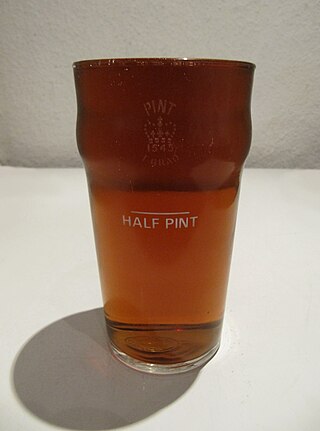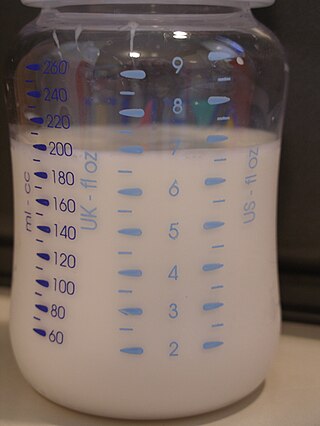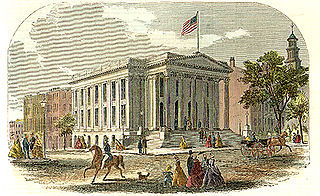Related Research Articles

The gallon is a unit of volume in British imperial units and United States customary units. Three different versions are in current use:

The imperial system of units, imperial system or imperial units is the system of units first defined in the British Weights and Measures Act 1824 and continued to be developed through a series of Weights and Measures Acts and amendments.

United States customary units form a system of measurement units commonly used in the United States and most U.S. territories, since being standardized and adopted in 1832. The United States customary system developed from English units that were in use in the British Empire before the U.S. became an independent country. The United Kingdom's system of measures was overhauled in 1824 to create the imperial system, which was officially adopted in 1826, changing the definitions of some of its units. Consequently, while many U.S. units are essentially similar to their imperial counterparts, there are significant differences between the systems.

In recipes, quantities of ingredients may be specified by mass, by volume, or by count.

The pint is a unit of volume or capacity in both the imperial and United States customary measurement systems. In both of those systems it is traditionally one eighth of a gallon. The British imperial pint is about 20% larger than the American pint because the two systems are defined differently. Almost all other countries have standardized on the metric system, so although some of them still also have traditional units called pints, the volume varies by regional custom.
The quart is an English unit of volume equal to a quarter gallon. Three kinds of quarts are currently used: the liquid quart and dry quart of the US customary system and the imperial quart of the British imperial system. All are roughly equal to one liter. It is divided into two pints or four cups. Historically, the exact size of the quart has varied with the different values of gallons over time and in reference to different commodities.

A fluid ounce is a unit of volume typically used for measuring liquids. The British Imperial, the United States customary, and the United States food labeling fluid ounce are the only three that are still in common use, although various definitions have been used throughout history.

A barrel is one of several units of volume applied in various contexts; there are dry barrels, fluid barrels, oil barrels, and so forth. For historical reasons the volumes of some barrel units are roughly double the volumes of others; volumes in common use range approximately from 100 to 200 litres. In many connections the term drum is used almost interchangeably with barrel.
A dunam, also known as a donum or dunum and as the old, Turkish, or Ottoman stremma, was the Ottoman unit of area equivalent to the Greek stremma or English acre, representing the amount of land that could be ploughed by a team of oxen in a day. The legal definition was "forty standard paces in length and breadth", but its actual area varied considerably from place to place, from a little more than 900 square metres (9,700 sq ft) in Ottoman Palestine to around 2,500 square metres (27,000 sq ft) in Iraq.
A system of units of measurement, also known as a system of units or system of measurement, is a collection of units of measurement and rules relating them to each other. Systems of measurement have historically been important, regulated and defined for the purposes of science and commerce. Instances in use include the International System of Units or SI, the British imperial system, and the United States customary system.
The following systems arose from earlier systems, and in many cases utilise parts of much older systems. For the most part they were used to varying degrees in the Middle Ages and surrounding time periods. Some of these systems found their way into later systems, such as the Imperial system and even SI.
English units are the units of measurement used in England up to 1826, which evolved as a combination of the Anglo-Saxon and Roman systems of units. Various standards have applied to English units at different times, in different places, and for different applications.

Metrication in Canada began in 1970 and ceased in 1985. Canada is now a functionally metric country in most areas of daily life and in most sectors with some specific exceptions in particular industries and other holdovers of habit. These holdovers are mainly due to historical ties with the United Kingdom, the traditional use of the imperial system of measurement in Canada, proximity to the United States, and strong public opposition to metrication during the transition period.

Both the British imperial measurement system and United States customary systems of measurement derive from earlier English unit systems used prior to 1824, that were the result of a combination of the local Anglo-Saxon units inherited from Germanic tribes and Roman units.

The imperial and US customary measurement systems are both derived from an earlier English system of measurement which in turn can be traced back to Ancient Roman units of measurement, and Carolingian and Saxon units of measure.
The quarter was used as the name of several distinct English units based on ¼ sizes of some base unit.
A number of different units of measurement were used in Argentina as its national system was derived from Spanish Castillian. The metric system was legally optional since 1863 and has been compulsory since 1887.
A number of units of measurement were used in Egypt to measure length, mass, area, capacity, etc. In Egypt, the metric system was made optional in 1873 and has been compulsory in government use since 1891.
A number of units of measurement were used in Mexico to measure length, mass, area, capacity, etc. The Metric system was optional from 1857, and has been compulsory since 1896.
A number of units of measurement were used in South Africa to measure quantities like length, mass, capacity, etc. The Imperial system of measurements was made standard in 1922 and the metric system was adopted in 1970.
References
- ↑ Cardarelli, F. (2003). Encyclopaedia of Scientific Units, Weights and Measures. Their SI Equivalences and Origins. London: Springer. p. 7. ISBN 978-1-4471-1122-1.
- 1 2 3 4 5 6 Washburn, E.W. (1926). International Critical Tables of Numerical Data, Physics, Chemistry and Technology. New York: McGraw-Hill Book Company, Inc. pp. 5.
international critical tables 1926.
- 1 2 3 4 5 6 Cardarelli, F. (2003). Encyclopaedia of Scientific Units, Weights and Measures. Their SI Equivalences and Origins. London: Springer. p. 96. ISBN 978-1-4471-1122-1.
- 1 2 Clarke, F.W. (1891). Weights Measures and Money of All Nations. New York: D. Appleton & Company. pp. 25, 26.